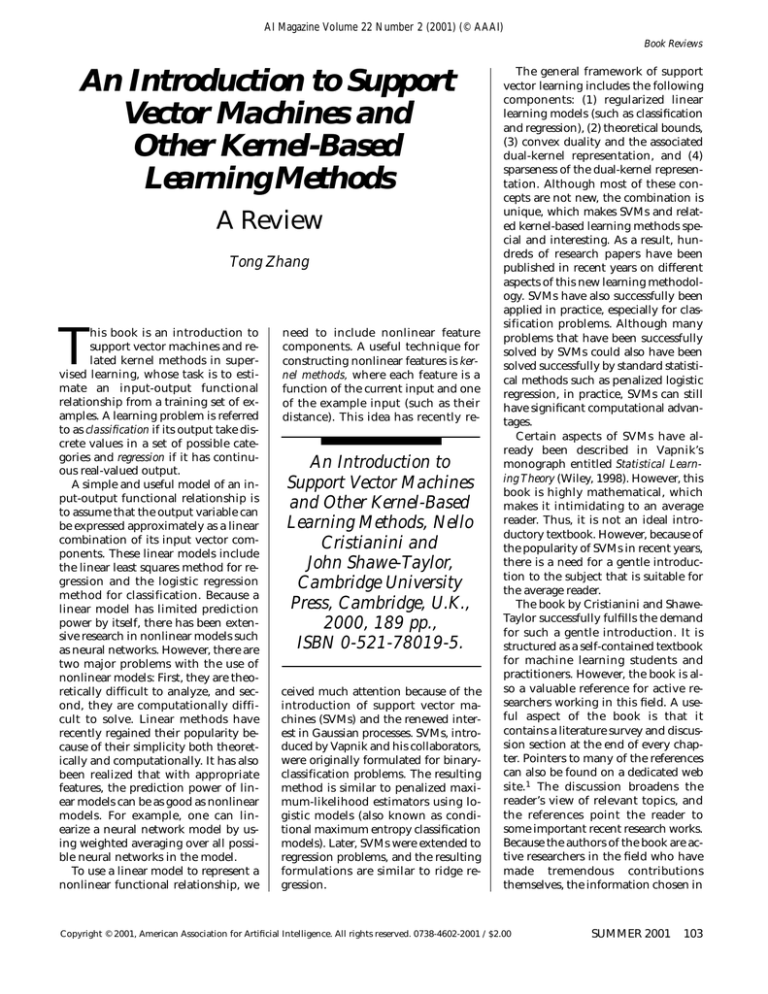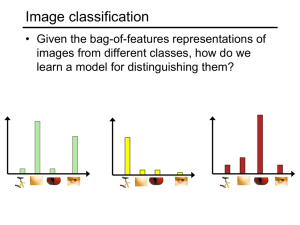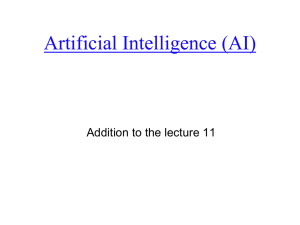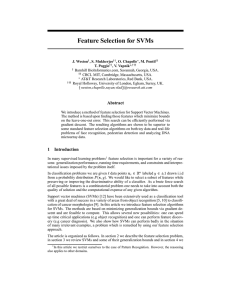
AI Magazine Volume 22 Number 2 (2001) (© AAAI)
Book Reviews
An Introduction to Support
Vector Machines and
Other Kernel-Based
Learning Methods
A Review
Tong Zhang
T
his book is an introduction to
support vector machines and related kernel methods in supervised learning, whose task is to estimate an input-output functional
relationship from a training set of examples. A learning problem is referred
to as classification if its output take discrete values in a set of possible categories and regression if it has continuous real-valued output.
A simple and useful model of an input-output functional relationship is
to assume that the output variable can
be expressed approximately as a linear
combination of its input vector components. These linear models include
the linear least squares method for regression and the logistic regression
method for classification. Because a
linear model has limited prediction
power by itself, there has been extensive research in nonlinear models such
as neural networks. However, there are
two major problems with the use of
nonlinear models: First, they are theoretically difficult to analyze, and second, they are computationally difficult to solve. Linear methods have
recently regained their popularity because of their simplicity both theoretically and computationally. It has also
been realized that with appropriate
features, the prediction power of linear models can be as good as nonlinear
models. For example, one can linearize a neural network model by using weighted averaging over all possible neural networks in the model.
To use a linear model to represent a
nonlinear functional relationship, we
need to include nonlinear feature
components. A useful technique for
constructing nonlinear features is kernel methods, where each feature is a
function of the current input and one
of the example input (such as their
distance). This idea has recently re-
An Introduction to
Support Vector Machines
and Other Kernel-Based
Learning Methods, Nello
Cristianini and
John Shawe-Taylor,
Cambridge University
Press, Cambridge, U.K.,
2000, 189 pp.,
ISBN 0-521-78019-5.
ceived much attention because of the
introduction of support vector machines (SVMs) and the renewed interest in Gaussian processes. SVMs, introduced by Vapnik and his collaborators,
were originally formulated for binaryclassification problems. The resulting
method is similar to penalized maximum-likelihood estimators using logistic models (also known as conditional maximum entropy classification
models). Later, SVMs were extended to
regression problems, and the resulting
formulations are similar to ridge regression.
The general framework of support
vector learning includes the following
components: (1) regularized linear
learning models (such as classification
and regression), (2) theoretical bounds,
(3) convex duality and the associated
dual-kernel representation, and (4)
sparseness of the dual-kernel representation. Although most of these concepts are not new, the combination is
unique, which makes SVMs and related kernel-based learning methods special and interesting. As a result, hundreds of research papers have been
published in recent years on different
aspects of this new learning methodology. SVMs have also successfully been
applied in practice, especially for classification problems. Although many
problems that have been successfully
solved by SVMs could also have been
solved successfully by standard statistical methods such as penalized logistic
regression, in practice, SVMs can still
have significant computational advantages.
Certain aspects of SVMs have already been described in Vapnik’s
monograph entitled Statistical Learning Theory (Wiley, 1998). However, this
book is highly mathematical, which
makes it intimidating to an average
reader. Thus, it is not an ideal introductory textbook. However, because of
the popularity of SVMs in recent years,
there is a need for a gentle introduction to the subject that is suitable for
the average reader.
The book by Cristianini and ShaweTaylor successfully fulfills the demand
for such a gentle introduction. It is
structured as a self-contained textbook
for machine learning students and
practitioners. However, the book is also a valuable reference for active researchers working in this field. A useful aspect of the book is that it
contains a literature survey and discussion section at the end of every chapter. Pointers to many of the references
can also be found on a dedicated web
site.1 The discussion broadens the
reader’s view of relevant topics, and
the references point the reader to
some important recent research works.
Because the authors of the book are active researchers in the field who have
made tremendous contributions
themselves, the information chosen in
Copyright © 2001, American Association for Artificial Intelligence. All rights reserved. 0738-4602-2001 / $2.00
SUMMER 2001
103
Book Reviews
the book reflects their unique, often
insightful perspectives.
The book contains eight chapters,
which cover topics including the
mathematical foundation of kernels,
Vapnik-Chervonenkis–style learning
theory, duality in mathematical programming, SVM formulations, implementation issues, and successful SVM
applications. Although these topics
are not comprehensive, they are carefully chosen. Some more advanced
materials are left out or barely mentioned in the book. Often, these advanced topics are still under active research and, thus, are not mature
enough to be included in an introductory text. Among the missing topics I
consider important are (1) approximation properties of kernel representation, (2) non–Vapnik-Chervonenkis–
style and non-margin–style theoretical
analysis, (3) the relationship between
SVM and regularization methods in
statistics and numeric mathematics,
(4) the impact of different regularization conditions and the impact of different loss terms, (5) direct-kernel formulations in the primal form (these
formulations have some advantages
over the dual-kernel formulations considered in the book), and (6) sparseness properties of the dual-kernel representation in an SVM (this aspect of
SVM is quite important and relates to
many ideas that existed before its introduction).
The book starts with a brief introduction to different learning models
and then focuses on linear learning
machines using perceptrons and least
squares regression. Many other linear
learning machines are not mentioned
in the book, probably because they are
less relevant to dual-kernel methods.
The concept of kernel-induced feature
space is developed in a subsequent
chapter. The authors include some
novel and very interesting kernel examples, such as a string kernel that induces a feature space consisting of all
possible subsequences in a string. The
main advantage of kernel-induced feature spaces is the ability to represent
nonlinear functions linearly in a space
spanned by the kernel functions. Although a kernel representation can
naturally be obtained from the dual
form of SVMs as presented in the
104
AI MAGAZINE
For Other Good Books on
Artificial Intelligence,
Please Visit the AAAI Press Website!
(www.aaaipress.org)
book, it can also be formulated directly in a primal-form learning machine.
The book has a nicely written chapter on the learning theory aspect of
SVMs, mainly from the Vapnik-Chervonenkis analysis and the maximal
margin point of view. The authors
have made substantial contributions
in the theoretical development of the
field, and the material selection in this
chapter reflects their perspective on
the problem. These theoretical results
are later used to motivate some specific SVM formulations considered in the
book. As acknowledged by the authors, this approach only leads to
learning methods that reflect what are
given in the theoretical bounds, which
might not be optimal. In addition, for
computational reasons, in the later
proposed formulations, there are some
heuristics not directly reflected in the
theoretical results. For these reasons,
the theory itself does not justify SVMs
as a method superior to other standard
statistical methods, such as logistic regression for classification or least
squares for regression. In fact, one
might start with non-SVM formulations and develop similar theoretical
results.
Following the theoretical analysis
chapter, the book gives an introduction of optimization and Lagrangian
duality theory, which is an essential
component of support vector learning.
Motivated by the theoretical bounds
given earlier, a number of specific SVM
formulations are presented. By using
the Lagrangian duality theory, these
SVMs are transformed into dual forms
using kernel representation. Some implementation issues that are useful for
practitioners are carefully discussed.
Although this book mainly considers
the standard approach to obtaining
dual-kernel representation using Lagrangian duality, we can also use kernel representation directly in primalform linear learning machines. The
latter approach does not require the
Lagrangian duality theory and can be
made either equivalent or non-equivalent to the dual-kernel formulation.
Although this book does not include all aspects of learning methods
related to SVMs, it achieves the right
balance of topic selection, clarity, and
mathematical rigor as an introductory
text. The topics covered in the book
are the most fundamental and important ones in support vector learning
and related kernel methods. This book
is essential both for practitioners who
want to quickly learn some implementation tricks to apply SVMs to real
problems and for theoretically oriented readers who want to understand
the mathematical foundations of the
underlying theory. It is also a handy
reference book for researchers working
in the field.
Note
1. www.support-vector.net.
Tony Zhang received a B.A. in mathematics and computer science from Cornell University in 1994 and a Ph.D. in computer science from Stanford University in 1998.
Since 1998, he has been with IBM Research,
T. J. Watson Research Center, Yorktown
Heights, New York, where he is now a research staff member in the Mathematical
Sciences Department. His research interests
include machine learning, numeric algorithms, and their applications. His e-mail
address is tzhang@watson.ibm.com.







